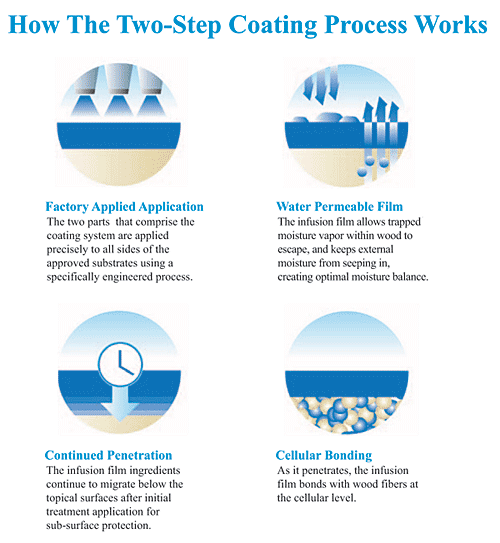Preventing Moisture-Related Problems in Residential Wood Framing
The Responsibility of Moisture Management
Who is responsible for moisture management during a residential
project? Lumber, plywood panel, and OSB manufacturers do not
warrant for mold growth. Per building codes, builders are not required to treat the majority of the wood components on projects to provide any sort of preventative protection against moisture-related problems. Contractors cannot control the levels of moisture to which wood
is exposed on the job site. Builders' Risk policies and Homeowners' insurance have fungus exclusions placing the detection and remediation of mold, a moisture-related problem, clearly outside the bailiwick
of coverage.
Until recently the industry attempted to address moisture exposure by modifying the construction process. Wraps, for instance, were applied to houses, but with only moderate success. Victims of poor installation technique, some of the wraps actually ended up trapping moisture against the wood, instead of providing an effective barrier.
In the last six years, the building industry has begun to address moisture issues by introducing new product treatments onto the market that are designed to protect the vulnerable building envelope. With the availability of new products, architects are in a better place than ever to make an impact. Architects can help clients by specifying products that prevent and protect the wood components against mold, rot fungi, and termites. "We continually evaluate products that not only meet our project demands, but also address our client's needs for cost efficiency, safety, and durability. New technologies for protecting wood framing components present added value opportunities for all types of construction," said Joel Carter from Carter Architecture, Myrtle Beach, SC.
Preventative Treatments for Wood Framing
One very common area for mold growth and other moisture−related problems to begin is any place in which two or more pieces of wood are fitted together with the potential threat of water getting in between them.
Today, there are three ways to protect wood components in the building envelope from moisture-related problems. They are a job site spray that prevents mold and microbial growth, a two-step coating process that protects wood from mold, rot fungi, and termites, and a pressure treatment that prevents termite damage and wood rot.
Job Site Spray
Open up any Yellow Pages and flip to the Contractor section. In cities all over the United States there are contractors dedicated to protecting and eliminating mold and microbial growth on the surface of wood products in a home. These specialized contractors will visit the job site and apply a chemical spray to the completed superstructure of the
project, protecting the treated surfaces from mold growth. After the spray is completed, construction can resume usually after only a delay of a couple of days.
It has been suggested that some job site spray treatments can deliver protective benefits for up to 25 years. These spray-on treatments do not provide protection against termites or rot fungi.
There are many different types of chemical spray and even patented application methods, so the services of each contractor should be reviewed thoroughly before a selection is made. Beyond the limited protection provided, common complaints about the job site spray include possible scheduling conflicts, inconsistent application, and incomplete coverage associated with on-site application. Since the spray is applied after the superstructure is erected, many potential problem areas do not receive treatment, because they simply are not accessible. This treatment also does not begin protecting the wood on the project until the house is almost complete and it does not assist wood components in regulating moisture absorption, it just makes mold unable to grow on the treated surfaces.
Two-step Coating Process
The most recent development in wood protection is a two-step coating process that protects wood framing components from mold, rot fungi, termites, and other wood ingesting insects.
The first step applies a semi-vapor permeable film that encapsulates all six sides of each piece of lumber on the project. The film makes the wood water-repellent and controls its natural moisture absorption capabilities, while allowing moisture vapor to escape from within.
The wood continues to breathe, which helps to contain normal moisture levels from within. By limiting the absorption of uncontrollable moisture, both topically and subsurface, wood components coated with this film are more stable and able to withstand extreme weather conditions. Beyond protecting wood by managing the presence of moisture within, the film itself is also specially formulated to resist mold fungus growth on the cured surface of the film.
|
The second step treats the wood framing components with Disodium Octaborate Tetrahydrate (DOT). DOT is an EPA-registered fungicide and pesticide that protects against wood ingesting insects, including subterranean and Formosan termites.
Wood products are coated at the factory and arrive on the job site protected from the elements and ready for installation, which helps builders avoid costly construction interruptions and inspection delays. These coated wood components can be stored outside and unprotected for six months.
This two-step coating process protects each inch of the wooden superstructure of a house from moisture and moisture-related problems, because each piece of wood or lumber is individually treated at the factory, before arriving on the job site. It can be applied to all of the wood framing components used in a covered structure, which includes: structural lumber, plywood, OSB, sub-floor panel products, EWP, truss products, moldings, and trim boards. Roof systems, wall systems, and floor systems can all be protected.
These factory-applied two-step solutions bond with the wood at a molecular level, offering lifetime protection.










